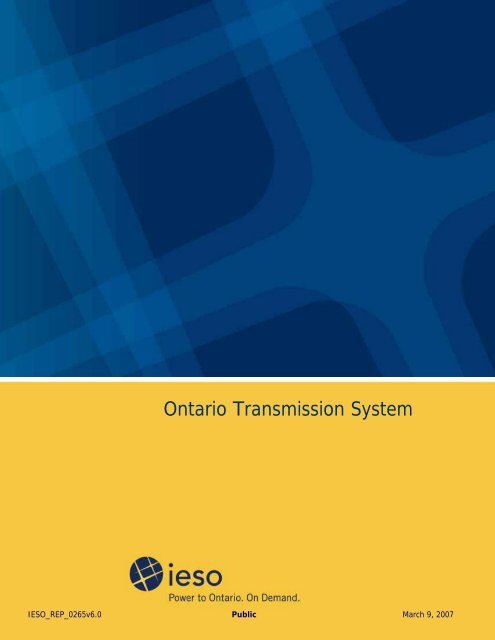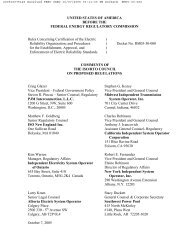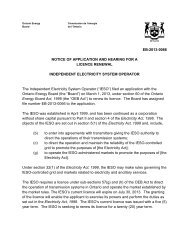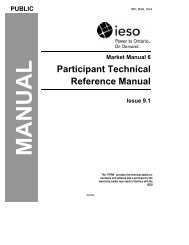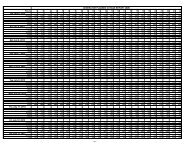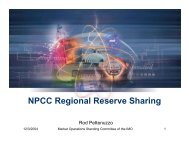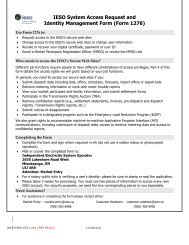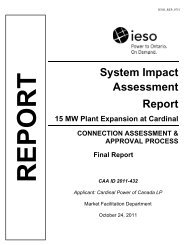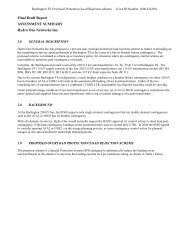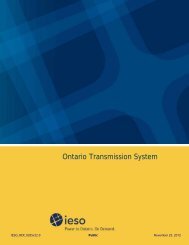Ontario Transmission System - IESO
Ontario Transmission System - IESO
Ontario Transmission System - IESO
Create successful ePaper yourself
Turn your PDF publications into a flip-book with our unique Google optimized e-Paper software.
<strong>IESO</strong>_REP_0265v6.0<strong>Ontario</strong> <strong>Transmission</strong> <strong>System</strong>Caution and DisclaimerThe contents of these materials are for discussion and information purposes and are provided “as is”without representation or warranty of any kind, including without limitation, accuracy, completeness orfitness for any particular purpose. The Independent Electricity <strong>System</strong> Operator (<strong>IESO</strong>) assumes noresponsibility to you or any third party for the consequences of any errors or omissions. The <strong>IESO</strong> mayrevise these materials at any time in its sole discretion without notice to you. Although every effort willbe made by the <strong>IESO</strong> to update these materials to incorporate any such revisions it is up to you to ensureyou are using the most recent version.March 9, 2007 Public Page iii
Table of Contents<strong>IESO</strong>_REP_0265v6.0<strong>Ontario</strong> <strong>Transmission</strong> <strong>System</strong>Table of ContentsTable of Contents ...............................................................................................v1.0 Introduction............................................................................................12.0 Current <strong>Transmission</strong> <strong>System</strong> Configuration .........................................33.0 <strong>Transmission</strong> Interfaces .........................................................................93.1 Interface Definitions ................................................................................................. 93.2 Interface Capability Limits......................................................................................... 93.3 Interface Characteristics ......................................................................................... 104.0 <strong>Transmission</strong> Zones ...............................................................................174.1 Zone Characteristics ............................................................................................... 175.0 <strong>Transmission</strong> Interconnections ............................................................195.1 Interconnection Definitions ..................................................................................... 195.2 Interconnection Flow Limits .................................................................................... 195.3 Interconnection Characteristics................................................................................ 21List of TablesTable 3.2 Interface Base Limits ...................................................................................................... 10Table 5.2 Interconnection Limits .................................................................................................... 20List of FiguresFigure 2.1.1 <strong>Ontario</strong>’s Major Internal Transfer Interfaces.................................................................... 4Figure 2.1.2 <strong>Ontario</strong>’s Points of Interconnection with Neighbouring Areas ............ Error! Bookmark notdefined.Figure 2.1.3 <strong>Ontario</strong>’s Zones, Interfaces and Interconnections ............................................................ 6Figure 2.1.4 <strong>Ontario</strong> with Zones Superimposed.................................................................................. 7Figures 3.3.1 Historical Flow Distribution – Interfaces....................................................................... 12Figures 5.3.1 Historical Flow Distribution - Interconnections ............................................................. 24March 9, 2007 Public Page v
1.0 Introduction <strong>IESO</strong>_REP_0265v6.0<strong>Ontario</strong> <strong>Transmission</strong> <strong>System</strong>1.0 IntroductionThe <strong>Ontario</strong> Electricity Market Rules (Chapter 5) require that the Independent Electricity <strong>System</strong>Operator (<strong>IESO</strong>) provide forecasts and assessments of the reliability of the existing and committedresources and transmission facilities of the <strong>Ontario</strong> Market.These forecasts and assessments of the <strong>Ontario</strong> Electricity <strong>System</strong> are contained in the <strong>IESO</strong> 18‐Monthand <strong>Ontario</strong> Reliability Outlooks.This document is intended to complement the transmission assessments contained in both Outlooks byproviding specific details on the <strong>Ontario</strong> transmission system, including the major internal transmissioninterfaces and interconnections with neighbouring jurisdictions.Readers are invited to provide comments and/or suggestions on this document. To do so, please contactus at:• Toll Free: 1‐888‐448‐7777• Tel: 905‐403‐6900• Fax: 905‐403‐6921• E‐mail: customer.relations@ieso.ca.‐ End of Section ‐March 9, 2007 Public Page 1 of 26
<strong>IESO</strong>_REP_0265v6.0<strong>Ontario</strong> <strong>Transmission</strong> <strong>System</strong>This page intentionally left blank.March 9, 2007 Public Page 2 of 26
2.0 Current <strong>Transmission</strong> <strong>System</strong> Configuration <strong>IESO</strong>_REP_0265v6.0<strong>Ontario</strong> <strong>Transmission</strong> <strong>System</strong>2.0 Current <strong>Transmission</strong> <strong>System</strong>ConfigurationThe <strong>Ontario</strong> transmission system is generally comprised of a 500 kV transmission network, a 230 kVtransmission network and several 115 kV transmission networks.Figures 2.1.1 and 2.1.2 provide a geographic depiction of <strong>Ontario</strong>’s internal transmission zones, majortransmission interfaces, and transmission interconnection points with other jurisdictions.Operating security limits for these interfaces and interconnections are also included in Figures 2.1.1 and2.1.2. An explanation of the limit values shown in the tables is contained in Sections 3.3 and 5.3. Theinterconnection and interface limits are used to ensure system and/or plant stability, acceptable precontingencyand post‐contingency voltage levels and/or acceptable thermal loading levels.Figure 2.1.3 provides a simplified depiction of Figures 2.1.1 and 2.1.2 and indicates the transmissionzones that are described in more detail in Section 4.0.Figure 2.1.4 shows <strong>Ontario</strong> with the transmission zones superimposed.March 9, 2007 Public Page 3 of 26
2.0 Current <strong>Transmission</strong> <strong>System</strong> Configuration <strong>IESO</strong>_REP_0265v6.0<strong>Ontario</strong> <strong>Transmission</strong> <strong>System</strong>Figure 2.1.1 <strong>Ontario</strong>’s Major Internal Transfer InterfacesJames BayMooseRiverAbitibiRiverRedLakeTroutLakeLacSeulLake St.JosephAlbanyRiverNORTHWESTMattagamiRiverLakethe ofWoodsFortFrancesSioux LookoutNORTHWESTLakeNipigonGeraldtonManitouwadgeLakSuperio erEWTWWawaEWTESault Ste. MarieTimminsNORTHEASTMWEWTE 325EWTW 350CLAN 2,000CLAS 1,000FN 1,900FS 1,400SudburyMINNESOTALakeTimiskamingLake Nipissing North BayThunder BayUNITED STATESLakeSuperiorQUEBECMWCANADATEC normally not limitingFIO 1,900EWTWEWTEWawaMWBLIP 3,500NBLIP 1,500FABCMICHIGAN4,050-4,450 w ith four Bruce Bunits in-service4,440-4,950 w ith five Bruce unitsin-service4,500-5,300 w ith six 500 kVLake HuronBruce units in-serviceBRUCEGeorgian BayFABCOwenSoundFNFSLake SimcoeBarrieCLANESSAPeterboroughTECBellevilleEASTKingstonFIOOTTAWAOttawaBrockvilleOttawaRiverSt LawrenceRiverWindsorSarniaBLIPWESTChathamLondonOrangevilleCANADAUNITEDSTATESKitchenerSOUTHWESTNBLIPLakeErieFETTQFWTORONTOCLASHamiltonTorontoNiagara FallsNIAGARALake <strong>Ontario</strong>CANADAUNITEDSTATESMWNEW YORKFETT - m axim um 5,600FETTIn the summer period, if the <strong>Ontario</strong> Demand(OD) exceeds 25,400 MW, the FETT maximumlimit is reduced by [0.3(PD-25400)] MW.QFW1,750 Summer, 1,950 WinterNotes to Figure 2.1.1:1. Tables indicate interface base limits (all transmission elements in-service). See Section 3.0 for further details.March 9, 2007 Public Page 4 of 26
2.0 Current <strong>Transmission</strong> <strong>System</strong> Configuration <strong>IESO</strong>_REP_0265v6.0<strong>Ontario</strong> <strong>Transmission</strong> <strong>System</strong>Figure 2.1.2 <strong>Ontario</strong>’s Points of Interconnection with Neighbouring AreasManitoba Into <strong>Ontario</strong> Out of <strong>Ontario</strong>summer 331 MW 263 MWw inter 343 MW 275 MWMinnesota Into <strong>Ontario</strong> Out of <strong>Ontario</strong>summer/w inter 90 MW 140 MWQuebec North Into <strong>Ontario</strong> Out of <strong>Ontario</strong>summer 65 MW 95 MWw inter 84 MW 110 MWQuebec South(East) Into <strong>Ontario</strong> Out of <strong>Ontario</strong>summer 800 MW 420 MWw inter 800 MW 470 MWQuebec South(Ottawa) Into <strong>Ontario</strong> Out of <strong>Ontario</strong>summer 748 MW 147 MWw inter 748 MW 167 MWNew York St.Lawrence Into <strong>Ontario</strong> Out of <strong>Ontario</strong>summer/w inter 400 MW 400 MWNew YorkNiagara Into <strong>Ontario</strong> Out of <strong>Ontario</strong>summer 1,300 MW 1,300 MWw inter 1,650 MW 1,950 MWMichiganInto <strong>Ontario</strong> Out of <strong>Ontario</strong>summer 1,550 MW 2,150 MWwinter 1,800 MW 2,400 MWNotes to Figure 2.1.2:1. Tables indicate flow limits for each interconnection. Note the <strong>Ontario</strong> coincident import/export capability is notnecessarily the arithmetic sum of the individual flow limits. See Section 5.0 for further details.March 9, 2007 Public Page 5 of 26
2.0 Current <strong>Transmission</strong> <strong>System</strong> Configuration <strong>IESO</strong>_REP_0265v6.0<strong>Ontario</strong> <strong>Transmission</strong> <strong>System</strong>Figure 2.1.3 <strong>Ontario</strong>’s Zones, Interfaces and Interconnections<strong>Ontario</strong>'s Internal Zones, Internal Interfaces and External InterconnectionsManitobaInterconnection(PAR Controlled)NorthwestZoneEWTEEWTWNortheastZoneQuebecInterconnection(Radial)MinnesotaInterconnection(PAR Controlled)FSFNBruceZoneEssaZoneOttawaZoneQuebecInterconnection(Radial)FABCCLASCLANFIOBLIPNBLIPFETTMichiganInterconnection(Partial PARControlled)WestZoneSouthwestZoneQFWNiagaraZoneTorontoZoneTECEastZoneNew YorkInterconnection(PAR Controlled)QuebecInterconnection(Radial)New YorkInterconnection(Free Flowing)Notes to Figure 2.1.3:1. See Section 4.0 for further details on the <strong>Ontario</strong> transmission zones.March 9, 2007 Public Page 6 of 26
2.0 Current <strong>Transmission</strong> <strong>System</strong> Configuration <strong>IESO</strong>_REP_0265v6.0<strong>Ontario</strong> <strong>Transmission</strong> <strong>System</strong>Figure 2.1.4 <strong>Ontario</strong> with Zones SuperimposedJames BayAbitibi RiverMooseRiverMANITOBARed LakeTrout LakeLake St. JosephAlbany RiverLac SeulNORTHWESTMattagami RiverSioux LookoutLake ofthe WoodsFortFrancesNORTHWESTLakeNipigonGeraldtonManitouwadgeWawaTimminsMINNESOTAThunder BayLakeSuperiorCANADAUNITED STATESWawaLakeSuperiorLake TimiskamingQUEBECNORTHEASTSault Ste. MarieSudburyLake Nipissing North BayOttawa RiverOTTAWAGeorgian BayOttawaLake HuronBRUCEOwenSoundLake SimcoeBarrieESSAPeterboroughEASTKingstonBrockvilleSt Lawrence RiverOrangevilleBellevilleMICHIGANSOUTHWESTKitchenerHamiltonTORONTOCANADALake <strong>Ontario</strong>UNITED STATESSarniaLondonNIAGARAWESTWindsorChathamCANADALake ErieUNITED STATESNEW YORK‐ End of Section ‐March 9, 2007 Public Page 7 of 26
<strong>IESO</strong>_REP_0265v6.0<strong>Ontario</strong> <strong>Transmission</strong> <strong>System</strong>This page intentionally left blank..March 9, 2007 Public Page 8 of 26
3.0 <strong>Transmission</strong> Interfaces <strong>IESO</strong>_REP_0265v6.0<strong>Ontario</strong> <strong>Transmission</strong> <strong>System</strong>3.0 <strong>Transmission</strong> InterfacesThere are nine major internal interfaces in the <strong>Ontario</strong> transmission system as illustrated in Figure 2.1.3.Detailed information on interface definitions and limits can be found in <strong>IESO</strong> <strong>System</strong> Control Orders(SCOs). The release of SCO limit related information to market participants will be considered by the<strong>IESO</strong> on a need to know and case by case basis. Requests for further information should be directed tothe <strong>IESO</strong> Customer Relations.3.1 Interface DefinitionsInterface definitions are formed by grouping one or more lines for the purpose of measuring theircombined flow and enforcing a power flow limit or, as it is more commonly, called an interface limit.Interface limits are directional and interfaces may have limits imposed in one or both directions.3.2 Interface Capability LimitsTable 3.2 summarizes the base limits for the major interfaces in <strong>Ontario</strong>; normal system (all transmissionelements in‐service) limits are shown. Emergency transfer limits are also shown where there are differentlimits for emergency conditions.Note that some limits are simple constants (e.g. BLIP) whereas others are more complicated and maydepend on parameters such as status of specific generator units, other transmission flows, <strong>Ontario</strong>demand, etc. (e.g. NBLIP, FETT, FABC). In cases where interface limits are based on thermal capability,separate ratings are shown for summer and winter conditions.March 9, 2007 Public Page 9 of 26
3.0 <strong>Transmission</strong> Interfaces <strong>IESO</strong>_REP_0265v6.0<strong>Ontario</strong> <strong>Transmission</strong> <strong>System</strong>in particular FABC and FETT, are valid. A sample of historical flow distribution on the CLAN/CLASinterface is shown in the Figures 3.3.1.The FABC InterfaceThe Flow Away from Bruce Complex (FABC) limit depends on the number of Bruce units in‐service, theBLIP/NBLIP interface flow and a number of other system parameters. The FABC limit is required forpreserving system and/or plant stability, and maintaining acceptable post‐contingency voltages. Separatestability and voltage limits are defined for each recognized contingency. The limit ranges presented inthis document are based on the most restrictive contingency.With four Bruce B units and all transmission elements in‐service, the FABC interface limit will range from4,050 MW to 4,450 MW depending on the BLIP/NBLIP interface flow. The impact of other systemparameters such as reactive support provided from other generating stations and reactor switchingavailability would likely result in a lower limit.With five Bruce units and all transmission elements in‐service, the FABC interface limit will range from4,440 W to 4,950 MW depending on the BLIP/NBLIP interface flow. With six 500 kV Bruce units and alltransmission elements in‐service, the FABC interface limit will range from 4,500 MW to 5,300 MWdepending on the BLIP/NBLIP interface flow. For both of these cases, the impact of other systemconditions would likely result in lower limits.With four or more Bruce units in‐service, the FABC limit can be improved through the use of generationrejection (G/R) of Bruce units, such that the full station output can normally be achieved. The resultinglimit improvements with G/R are not specified in this document, but are described in detail in theappropriate SCO.The BLIP/NBLIP InterfaceThe Buchanan Longwood Input (BLIP) interface is limited to 3,500 MW to the west due to stability andvoltage limitations. The Negative Buchanan Longwood Input (NBLIP) interface limit is a function of avariety of parameters. Normally the limit is near its high end of about 1,500 MW. The interface istypically constrained by voltage limitations. A sample of historical flow distribution on the BLIPinterface is shown in the Figures 3.3.1.The QFW InterfaceThe Queenston Flow West (QFW) interface is limited to 1,950 MW for flows to the west in the winter. Inthe summer, the limit is 1,750 MW to the west. This interface is constrained by thermal limitations. Thereis no limit specified for flows to the east, as the level of flows expected in that direction will not causesystem concerns. A sample of historical flow distribution on the QFW interface is shown in theFigures 3.3.2.The FETT InterfaceThe Flow East Towards Toronto (FETT) interface limit is a function of a variety of parameters such as<strong>Ontario</strong> demand and reactive support provided from various generating stations. As a result, the limit ofthis interface is generally lower than its maximum limit of 5,600 MW. The interface is constrained by acombination of stability and thermal limits. There is no limit specified for flows to the west, as thecurrent level of flows expected in that direction will not cause system concerns. A sample of historicalflow distribution on the FETT interface is shown in the Figures 3.3.1.March 9, 2007 Public Page 11 of 26
3.0 <strong>Transmission</strong> Interfaces <strong>IESO</strong>_REP_0265v6.0<strong>Ontario</strong> <strong>Transmission</strong> <strong>System</strong>The TEC InterfaceThe Transfer East from Cherrywood (TEC) interface does not have a pre‐defined limit for up to any onesingle element out of service. The TEC interface is included to provide a boundary between the Torontoand East transmission zones. With these zones defined, specific studies can be conducted to consider theimpact of varying resource dispatch scenarios on reliability.The FIO InterfaceThe Flow Into Ottawa (FIO) interface is limited to 1,900 MW to control post‐contingency voltage declinesin the Ottawa zone. There is no limit specified on this interface for flows to the East zone. The FIO limitcan be improved with the use of load rejection in the Ottawa zone. A sample of the historical flowdistribution on the FIO interface is shown in Figures 3.3.1.Figures 3.3.1 Historical Flow Distribution – InterfacesEWTE/EWTW 2006400300EWTE Limit200100EWTE (MW)-10000 10 20 30 40 50 60 70 80 90 100-200-300EWTW Limit-400percentage of time (%)March 9, 2007 Public Page 12 of 26
3.0 <strong>Transmission</strong> Interfaces <strong>IESO</strong>_REP_0265v6.0<strong>Ontario</strong> <strong>Transmission</strong> <strong>System</strong>FN/FS 200625002000FN Limit15001000FN (MW)50000 10 20 30 40 50 60 70 80 90 100-500-1000FS Limit-1500-2000percentage of time (%)CLAN/CLAS 20062500CLAN Limit200015001000CLAN (MW)50000 10 20 30 40 50 60 70 80 90 100-500CLAS Limit-1000-1500percentage of time (%)March 9, 2007 Public Page 13 of 26
3.0 <strong>Transmission</strong> Interfaces <strong>IESO</strong>_REP_0265v6.0<strong>Ontario</strong> <strong>Transmission</strong> <strong>System</strong>BLIP/NBLIP 20064000BLIP Limit30002000BLIP (MW)100000 10 20 30 40 50 60 70 80 90 100-1000BLIP Limit-2000percentage of time (%)QFW 200625002000QFW Winter Limit1500QFW Summer Limit1000QFW (MW)50000 10 20 30 40 50 60 70 80 90 100-500-1000-1500percentage of time (%)March 9, 2007 Public Page 14 of 26
3.0 <strong>Transmission</strong> Interfaces <strong>IESO</strong>_REP_0265v6.0<strong>Ontario</strong> <strong>Transmission</strong> <strong>System</strong>FETT 200660005000FETT Limit40003000FETT (MW)2000100000 10 20 30 40 50 60 70 80 90 100-1000-2000percentage of time (%)FIO 200620001800FIO Limit160014001200FIO (MW)100080060040020000 10 20 30 40 50 60 70 80 90 100percentage of time (%)‐ End of Section –March 9, 2007 Public Page 15 of 26
3.0 <strong>Transmission</strong> Interfaces <strong>IESO</strong>_REP_0265v6.0<strong>Ontario</strong> <strong>Transmission</strong> <strong>System</strong>This page intentionally left blank.March 9, 2007 Public Page 16 of 26
4.0 <strong>Transmission</strong> Zones <strong>IESO</strong>_REP_0265v6.0<strong>Ontario</strong> <strong>Transmission</strong> <strong>System</strong>4.0 <strong>Transmission</strong> ZonesThe <strong>Ontario</strong> transmission system has been divided into ten zones as illustrated in Figure 2.1.3. Zonalboundaries have been chosen to correspond with the major interfaces described in Section 3.0.4.1 Zone CharacteristicsBruce Zone• The total resources are much greater than the zone peak demand.• The generation is mostly nuclear.• There are no external interconnections.East Zone• The total resources exceed the zone peak demand.• The generation is a mix of hydroelectric, oil and gas.• The zone is externally connected to the Quebec grid.• The existing interconnection with Quebec is radial.• The zone is also externally connected to the St. Lawrence interface with New York via phase angleregulator control.Essa Zone• The total resources are much less than the zone peak demand.• The generation is totally hydroelectric.• For analytical purposes, Des Joachims generation and 115 kV load, which is physically located in theEast zone, has been modeled to be part of the Essa zone. The Essa zone is the primary point of receiptof Des Joachims generation.• There are no external interconnections.Niagara Zone• The total resources are much higher than the zone peak demand.• The total load consists of 25 Hz and 60 Hz loads.• The generation consists of 25 Hz and 60 Hz units, and is totally hydroelectric.• There is a free‐flowing interconnection with New York.March 9, 2007 Public Page 17 of 26
4.0 <strong>Transmission</strong> Zones <strong>IESO</strong>_REP_0265v6.0<strong>Ontario</strong> <strong>Transmission</strong> <strong>System</strong>Northeast Zone• The total resources exceed the zone peak demand.• The generation is mainly hydroelectric with some cogeneration, wind and wood waste.• There is some 25 Hz generation radially connected to the 60 Hz electricity system via a frequencychanger.• The existing interconnection with Quebec is radial.Northwest Zone• The total resources generally exceed the zone peak demand.• The generation is mainly hydroelectric with some coal and gas.• The zone is externally connected to the Manitoba and Minnesota systems.• The 230 kV Manitoba interconnections are under phase angle regulator control. The Manitoba 115 kVinterconnection is radial. The Minnesota 115 kV interconnection is under phase angle regulatorcontrol.Ottawa Zone• The total resources are much less than the zone peak demand.• The generation is cogeneration.• The existing interconnection with Quebec is radial.Southwest Zone• The total resources are generally balanced with the zone peak demand.• The generation is mostly coal with some wind.• The load consists of 25 Hz and 60 Hz.• There are no external interconnections.Toronto Zone• The total resources are less than the zone peak demand.• The generation is mostly nuclear with some gas.• There are no external interconnections.West Zone• The total resources are slightly less than the zone peak demand.• The generation is mostly coal with some gas and wind.• There is partial phase angle control on the interconnection with Michigan. At some future date, theinterconnection will be under full phase angle regulator control.‐ End of Section ‐March 9, 2007 Public Page 18 of 26
5.0 <strong>Transmission</strong> Interconnections <strong>IESO</strong>_REP_0265v6.0<strong>Ontario</strong> <strong>Transmission</strong> <strong>System</strong>5.0 <strong>Transmission</strong> InterconnectionsThe term interconnection is used to describe interfaces that join <strong>Ontario</strong> to other jurisdictions (externalcontrol areas).<strong>Ontario</strong> has interconnections with Manitoba, Minnesota, Quebec, Michigan, and New York.5.1 Interconnection DefinitionsLike transmission interfaces, interconnection definitions are formed by grouping one or more lines for thepurpose of measuring their combined flow and enforcing a power flow limit. Interconnections limits aredefined for flows into <strong>Ontario</strong> (imports) and out of <strong>Ontario</strong> (exports).5.2 Interconnection Flow LimitsTable 5.2 summarizes the flow limits for the interconnections; normal system (all transmission elementsin‐service) limits are shown. In addition, emergency transfer limits are shown when they differ from thenormal system limits.For Manitoba and Minnesota, the flow limits recognize dead‐band margins associated with the phaseangle regulator taps.For Michigan and New York, flow limits are given for summer and winter flows into and out of <strong>Ontario</strong>.The flow limits account for the automatic generation control (AGC) process required to match load andgeneration within <strong>Ontario</strong>. With favourable conditions, the flow capabilities of the interconnections willnot be affected by internal limitations in the transmission network. The amount of power that can betransferred may be lower than the table values under unfavourable dispatch and weather conditions.With unfavourable conditions, the flow capabilities may also be affected by internal limitations in thetransmission network, in <strong>Ontario</strong> or in external areas.When ambient weather conditions permit, flow limits over paths restricted by thermal considerationsmay be increased during real‐time operation.March 9, 2007 Public Page 19 of 26
5.0 <strong>Transmission</strong> Interconnections <strong>IESO</strong>_REP_0265v6.0<strong>Ontario</strong> <strong>Transmission</strong> <strong>System</strong>Table 5.2 Interconnection LimitsInterconnectionLimit - Flows Out of <strong>Ontario</strong>MWLimit - Flows Into <strong>Ontario</strong>MW(3)Manitoba – Summer*263 331 (4)(3)Manitoba – Winter*275 343 (4)Minnesota(3) 140 90Quebec North (Northeast) – Summer* 95 (5) 65Quebec North (Northeast)– Winter* 110 (4) 84Quebec South (Ottawa) – Summer* 147 748Quebec South (Ottawa) – Winter* 167 748Quebec South (East) – Summer* 420 800Quebec South (East) – Winter* 470 800New York St. Lawrence 400 400New York Niagara (60 Hz and 25 Hz) – Summer* 1,300 (1) 1,300 (5)(Emergency Transfer Limit - Summer) 2,100 (1) 1,750 (5)New York Niagara (60 Hz and 25 Hz) – Winter* 1,950 (1) 1,650 (5)(Emergency Transfer Limit - Winter) 2,100 (1) 2,100 (5)(2,3)Michigan – Summer*2,150 1,550*(2,3)Emergency Transfer Limit - Summer2,550 1,950(2,3)Michigan – Winter*2,400 1,800*(2,3)Emergency Transfer Limit - Winter2,650 2,000* Summer Limits apply from May 1 to October 31. Winter Limits apply from November 1 to April 30.(1) Flow limits depend on generation dispatch outside <strong>Ontario</strong>. Values presented here are based on generation dispatchprovided by New York.(2)Normal limits are based on LT ratings and phase shifters bypassed and Emergencty limits are based on ST ratings andphase shifters regulating . Flow limits vary depending on the generation dispatch within <strong>Ontario</strong>.(3) For real time operation of the interconnection, limits are based on ambient conditions.(4) Limit based on 0‐4 km/hr wind speed and 10 Deg.C ambient temperature.(5) Limit based on 0‐4 km/hr wind speed and 30 Deg.C ambient temperature.(4) Flows into <strong>Ontario</strong> include flows on circuit SK1.(5) Flow Limits into <strong>Ontario</strong> are shown here without considering QFW transmission constraints within <strong>Ontario</strong>.Considering internal QFW constraints, flow limit would be 1,000 MW in summer and 1,400 MW in winter.March 9, 2007 Public Page 20 of 26
5.0 <strong>Transmission</strong> Interconnections <strong>IESO</strong>_REP_0265v6.0<strong>Ontario</strong> <strong>Transmission</strong> <strong>System</strong>5.3 Interconnection CharacteristicsAll of <strong>Ontario</strong>’s non‐radial interconnections are linked with phase angle regulators (PARs), except forNew York – Niagara and one circuit between Michigan and <strong>Ontario</strong> where the PAR has failed.A sample of historical flow distribution on the <strong>Ontario</strong> interconnections is shown in Figure 5.3.1. Limitsare also shown on the diagrams except for New York and Quebec where flows are derived from morethan one interconnection.The <strong>Ontario</strong> – Manitoba Interconnection (60 Hz)The <strong>Ontario</strong> – Manitoba interconnection consists of two 230 kV circuits and one 115 kV circuit.The 230 kV interconnection is defined as the <strong>Ontario</strong>‐ Manitoba Transfer. The transfers on thisinterconnection are the <strong>Ontario</strong> – Manitoba Transfer East (OMTE) and the <strong>Ontario</strong> – Manitoba TransferWest (OMTW), and are constrained by stability and thermal limitations. The OMTW limits are 275 MWin the winter and 263 MW in the summer, while the OMTE limits are 331 MW in the winter and 343 MWin the summer.The 115 kV interconnection is limited to 68 MW for flows into <strong>Ontario</strong> in the wintertime andsummertime.<strong>Ontario</strong> and Manitoba are synchronously connected on the 230 kV interconnection, but are not on the115 kV interconnection.The <strong>Ontario</strong> – Minnesota Interconnection (60 Hz)The <strong>Ontario</strong> – Minnesota interconnection consists of one 115 kV circuit. The transfers on thisinterconnection are the Minnesota Power Flow North (MPFN) and the Minnesota Power Flow South(MPFS).The MPFN and MPFS limits are 90 MW and 140 MW respectively and are constrained by stability andthermal limitations. <strong>Ontario</strong> and Minnesota are synchronously connected.The <strong>Ontario</strong> – Michigan Interconnection (60 Hz)The <strong>Ontario</strong> – Michigan interconnection consists of two 230/345 kV circuits, one 230/115 kV circuit andone 230 kV circuit. The interconnection is constrained by thermal limitations.At the present time, the interconnection is operated with one phase angle regulator (PAR) in‐service atKeith T.S and three others by‐passed; two located at Lambton and one at Bunce Creek, Michigan.With the PARS by‐passed, for the flows out of <strong>Ontario</strong>, the winter and summer limits are 2,400 MW and2,150 MW, respectively. For the flows into <strong>Ontario</strong>, the winter and summer limits are 1,800 MW and1,550 MW, respectively. .The <strong>Ontario</strong> – New York Niagara Interconnection (60 Hz and 25 Hz)The <strong>Ontario</strong> – New York Niagara interconnection consists of 60 Hz and 25 Hz circuits at various voltagelevels. For the 60 Hz circuits, there are two 230/345 kV circuits, two 230 kV circuits and one 115 kVcircuit. For the 25 Hz circuits, there is one 115/69 kV circuit and one 69 kV circuit.March 9, 2007 Public Page 21 of 26
5.0 <strong>Transmission</strong> Interconnections <strong>IESO</strong>_REP_0265v6.0<strong>Ontario</strong> <strong>Transmission</strong> <strong>System</strong>The New York (NY) Niagara interconnection, in the winter, is limited to 1,650 MW for flows into <strong>Ontario</strong>and 1,950 MW for flows out of <strong>Ontario</strong>. In the summer, the limit is1,300 MW for flows into and out of<strong>Ontario</strong>. The interconnection is constrained by thermal limitations in the winter and summer.The Queenston Flow West (QFW) interface is in series with the NY Niagara interconnection. All flowsentering <strong>Ontario</strong> on the NY Niagara interconnection will also appear on the QFW interface; this includesimports and parallel path flows. Based on past experience and studies, the QFW interface always hits itslimit before the limit is reached on the NY Niagara interconnection for flows entering <strong>Ontario</strong>; as a result,the capability of the NY Niagara interconnection is never fully utilized. The QFW interface is constrainedby thermal limitations, which are very dependent on weather conditions.Typically, when QFW hits its limit of 1,750 MW under summer conditions, the flow across the NYNiagara interconnection is 1,000 MW. Similarly, when QFW hits its limit of 1,950 MW under winterconditions, flow across the NY Niagara interconnection is 1,200 MW.Similarly, at worst, internal constraints in New York can limit flows leaving <strong>Ontario</strong> to 700 MW and1,000 MW during the summer and winter periods, respectively.<strong>Ontario</strong> and New York Niagara are synchronously connected.The <strong>Ontario</strong> – New York St. Lawrence Interconnection (60 Hz)The <strong>Ontario</strong> – New York St. Lawrence interconnection consists of two 230 kV circuits. Theinterconnection is constrained by thermal limitations and is under the control of phase angle regulators.The limit on this interconnection is 400 MW for flows into or out of <strong>Ontario</strong>.<strong>Ontario</strong> and New York St. Lawrence are synchronously connected.The <strong>Ontario</strong> – Quebec North Interconnection (60 Hz)The <strong>Ontario</strong> – Quebec North Interconnection consists of two 115 kV circuits and is thermally limited.For flows into <strong>Ontario</strong> from radial generation in Quebec, the limit is 84 MW under winter conditions and65 MW under summer conditions. For flows out of <strong>Ontario</strong>, the limit is 110 MW in the wintertime and95 MW in the summertime. <strong>Ontario</strong> and Quebec North are non‐synchronously connected.The <strong>Ontario</strong> (Ottawa and East zones combined) – Quebec South Interconnection (60 Hz)The <strong>Ontario</strong> – Quebec South Interconnection consists of one 230/345 kV circuit, four 230 kV circuits andtwo 115 kV circuits.The interconnection is limited to 1,548 MW for flows into <strong>Ontario</strong> due to stability limitations andavailable radial generation. For flows out of <strong>Ontario</strong> the limits, due to stability and thermal limitations,are 567 MW for the summer and 637 MW for the winter. <strong>Ontario</strong> and Quebec South are nonsynchronouslyconnected.Parallel Path flows between Michigan & New York NiagaraWith partial phase angle regulator (PAR) control the <strong>Ontario</strong> – Michigan interconnection scheduledimports and exports between <strong>Ontario</strong> – Michigan and/or <strong>Ontario</strong> – New York Niagara are subjected toparallel path flows. These flows occur between Michigan and New York Niagara, north of Lake Eriethrough <strong>Ontario</strong> and south of Lake Erie through Pennsylvania, due to a combination of transmissionMarch 9, 2007 Public Page 22 of 26
5.0 <strong>Transmission</strong> Interconnections <strong>IESO</strong>_REP_0265v6.0<strong>Ontario</strong> <strong>Transmission</strong> <strong>System</strong>system impedance with interconnection‐wide load/generation dispatch. As a result, the actual flows onthe Michigan and New York Niagara interconnections may not equal the scheduled flows. For scheduled<strong>Ontario</strong> – Michigan power flows, part of the scheduled flows may flow on the NY Niagarainterconnection due to parallel path flows. Likewise, for scheduled <strong>Ontario</strong> – New York Niagara powerflows, part of the scheduled flows may flow on the <strong>Ontario</strong> – Michigan interconnection.Lake Erie Circulation (LEC) is a measure of the use of the <strong>Ontario</strong> transmission system by external partiesin neighbouring jurisdictions. It is an unscheduled parallel path flow that also occurs due to acombination of transmission system impedance with interconnection‐wide load/generation dispatch. It iscalculated using measured flows on the Michigan interconnection, measured flows on the New York St.Lawrence interconnection, scheduled Michigan transactions, scheduled New York transactions,measured Lambton generation and measured Beck generation. The flow can circulate through <strong>Ontario</strong> ina clockwise direction, in at Michigan and out at New York, or in counterclockwise direction, in at NewYork and out at Michigan. LEC flows also appear on and aggravate the BLIP and QFW interfaces as theyare in a direct series path.Without full PAR control of the <strong>Ontario</strong> – Michigan interconnection, power flows across the Michiganinterconnection are comprised of scheduled direct flows, scheduled New York Niagara parallel pathflows and LEC. Likewise, power flows across the New York Niagara interconnection are comprised ofscheduled direct flows, scheduled Michigan parallel path flows and LEC. This means that the totaltransfer from these two areas is usually limited to a flow that is less than the sum of the twointerconnection flow limits.When full PAR control of the <strong>Ontario</strong> – Michigan interconnection is utilized, parallel path flows of up to600 MW in either direction are expected to be controlled. Control of parallel path flows to levels less than600 MW should allow scheduled power flows to be maintained between <strong>Ontario</strong>, Michigan and NewYork, and should also greatly reduce the incidence of constrained operation of QFW interface.<strong>Ontario</strong> Coincident Import/Export CapabilityWith partial phase angle (PAR) control of the <strong>Ontario</strong> – Michigan interconnection, the coincidentimport/export capability is unlikely to equal the arithmetic sum of the individual flow limits. At best, thetotal transfer capability is the sum of the interconnection flow limits. At worst, the total transfercapability will equal the minimum of either the New York (St. Lawrence plus Niagara) or Michiganinterconnection flow limit, plus all other interconnection flow limits. In the summer, the interconnectionscan carry coincident exports from 2,765 MW up to 4,915 MW, and coincident imports from 3,734 MW upto 5,284 MW. In the winter, the interconnections can carry coincident exports from 3,512 MW up to5,912 MW, and coincident imports from 4,115 MW up to 5,915 MW.Previous studies have shown that when full PAR control is available on the <strong>Ontario</strong> – Michiganinterconnection, flow control of up to 600 MW could be achieved. When circulation is limiting, thiscontrol will act to improve the capability.The higher values associated with the <strong>Ontario</strong> coincident import ranges represent theoretical levels thatcould be achieved only with a substantial reduction in generation dispatch in the West and Niagaratransmission zones. In practice, the generation dispatch required for these high import levels wouldrarely, if ever, materialize. Therefore, at best, due to internal constraints in the <strong>Ontario</strong> transmissionnetwork, <strong>Ontario</strong> has an expected coincident import capability of approximately 4,000 MW.March 9, 2007 Public Page 23 of 26
5.0 <strong>Transmission</strong> Interconnections <strong>IESO</strong>_REP_0265v6.0<strong>Ontario</strong> <strong>Transmission</strong> <strong>System</strong>Figures 5.3.1 Historical Flow Distribution - Interconnections<strong>Ontario</strong> Net Export to Manitoba 2006400300Winter Limit200Summer LimitFlow into Manitoba (MW)10000 10 20 30 40 50 60 70 80 90 100-100-200-300Summer Limit-400Winter Limitpercentage of time (%)<strong>Ontario</strong> Net Export to Minnesota 2006200150LimitFlow into Minnesota (MW)1005000 10 20 30 40 50 60 70 80 90 100-50Limit-100-150percentage of time (%)March 9, 2007 Public Page 24 of 26
5.0 <strong>Transmission</strong> Interconnections <strong>IESO</strong>_REP_0265v6.0<strong>Ontario</strong> <strong>Transmission</strong> <strong>System</strong><strong>Ontario</strong> Net Export to Michigan 200630002500Winter Limit2000Summer Limit1500Flow into Michigan (MW)100050000 10 20 30 40 50 60 70 80 90 100-500-1000Summer Limit-1500-2000Winter Limit-2500percentage of time (%)<strong>Ontario</strong> Net Export to New York 2006250020001500Flow into New York (MW)100050000 10 20 30 40 50 60 70 80 90 100-500-1000-1500-2000-2500percentage of time (%)March 9, 2007 Public Page 25 of 26
5.0 <strong>Transmission</strong> Interconnections <strong>IESO</strong>_REP_0265v6.0<strong>Ontario</strong> <strong>Transmission</strong> <strong>System</strong><strong>Ontario</strong> Net Export to Quebec 2006800600400Flow into Quebec (MW)20000 10 20 30 40 50 60 70 80 90 100-200-400-600percentage of time (%)<strong>Ontario</strong> Net Export 200635002500Flow out of <strong>Ontario</strong> (MW)15005000 10 20 30 40 50 60 70 80 90 100-500-1500-2500-3500percentage of time (%)‐ End of Document ‐March 9, 2007 Public Page 26 of 26


